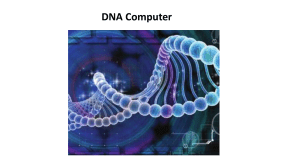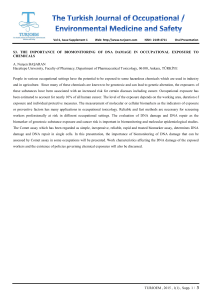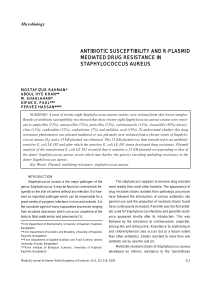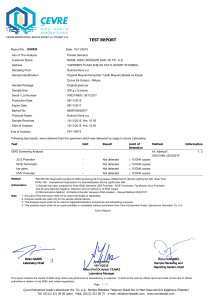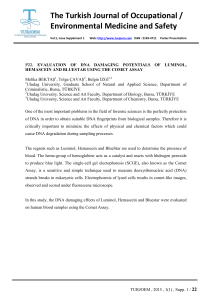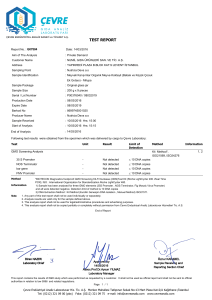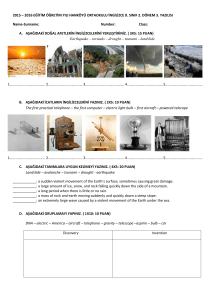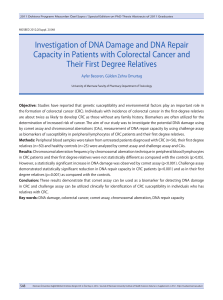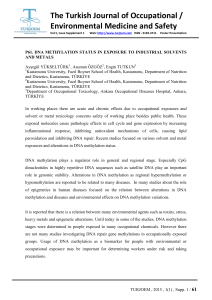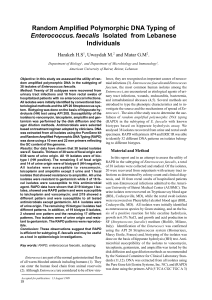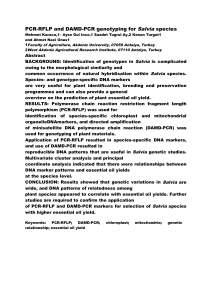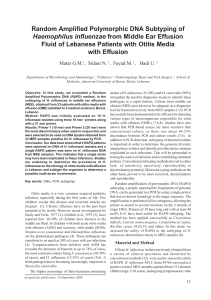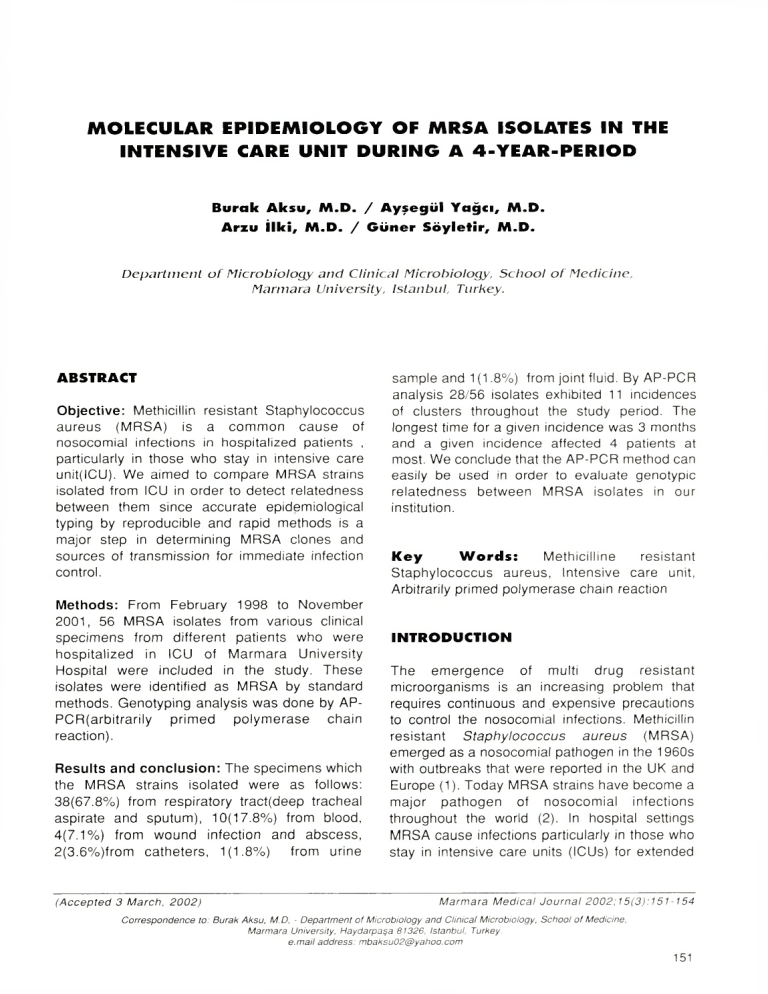
M O L E C U L A R
E P ID E M IO L O G Y
IN T E N S IV E
C A R E
U N IT
O F
M R S A
D U R IN G
A
IS O L A T E S
IN
T H E
4 -Y E A R -P E R IO D
Burak Aksu, M .D . / Ayşegül Yağcı, M .D .
Arxu İlk i, M .D . / Güner S öyletir, M .D .
D e p a r tm e n t o f M ic ro b io lo g y a n d C lin ic a l M ic ro b io lo g y , S c h o o l o f M e d ic in e ,
M a r m a ra U n iv e rs ity , Is ta n b u l, T u rk e y .
ABSTRACT
O b je ctiv e : Methicillin resistant Staphylococcus
aureus (MRSA) is a common cause of
nosocomial infections in hospitalized patients ,
particularly in those who stay in intensive care
unit(ICU). We aimed to compare MRSA strains
isolated from ICU in order to detect relatedness
between them since accurate epidemiological
typing by reproducible and rapid methods is a
major step in determining MRSA clones and
sources of transmission for immediate infection
control.
From February 1998 to November
2001, 56 MRSA Isolates from various clinical
specimens from different patients who were
hospitalized in ICU of Marmara University
Hospital were included in the study. These
isolates were identified as MRSA by standard
methods. Genotyping analysis was done by APPCR(arbitrarily primed polymerase chain
reaction).
sample and 1(1.8%) from joint fluid. By AP-PCR
analysis 28/56 isolates exhibited 11 incidences
of clusters throughout the study period. The
longest time for a given incidence was 3 months
and a given incidence affected 4 patients at
most. We conclude that the AP-PCR method can
easily be used in order to evaluate genotypic
relatedness between MRSA isolates in our
institution.
K ey
W ords:
Methicilline
resistant
Staphylococcus aureus, Intensive care unit,
Arbitrarily primed polymerase chain reaction
M eth o d s:
R e s u lts and c o n c lu s io n : The specimens which
the MRSA strains isolated were as follows:
38(67 .8%) from respiratory tract(deep tracheal
aspirate and sputum), 10(17.8%) from blood,
4 (7 .1%) from wound infection and abscess,
2 (3 .6%)from catheters, 1(1.8%) from urine
(A c c e p te d 3 M arch, 2 0 0 2 )
INTRODUCTION
The emergence of multi drug resistant
microorganisms is an increasing problem that
requires continuous and expensive precautions
to control the nosocomial infections. Methicillin
resistant Staphylococcus aureus (MRSA)
emerged as a nosocomial pathogen in the 1960s
with outbreaks that were reported in the UK and
Europe (1). Today MRSA strains have become a
major pathogen of nosocomial infections
throughout the world (2). In hospital settings
MRSA cause infections particularly in those who
stay in intensive care units (ICUs) for extended
M a r m a r a M e d i c a l J o u r n a l 2 0 0 2 ; 1 5 ( 3 ) : 1 51 - 1 5 4
Correspondence to: Burak Aksu, M.D, - Department ot Microbiology and Clinical Microbiology, School of Medicine,
Marmara University, Haydarpaşa 81326, Istanbul, Turkey,
e.mail address: [email protected]
151
B u ra k A k s u , e t a l
periods of time, have underlying illness and are
exposed to high frequency of invasive
procedures including mechanical ventilation,
catheterization etc. The main mechanism of
MRSA transmission is via the hands of hospital
staff in contact with patients or contaminated
patient materials (1).
Macherey Nagel, Germany) and processed by
manufacturers instructions. This method
allowed purification up to 35 pg genomic DNA for
PCR amplification. Amount of DNA was
detected by gel electrophoresis compared with
DNA marker.
P C R A m p lifica tio n :
In this respect the microbiology laboratory plays
an important role in the effort to minimize
nosocomial infections and serves as a warning
unit by identifying organisms that can be
transmitted through the hospital (3). In order to
achieve this aim genetic typing methods are
widely used to determine whether the organisms
are similar or different.
In this paper we analyze the genetic relationship
among MRSA strains from ICU patients in a 4 year period with arbitrarily primed polymerase
chain reaction (AP-PCR) assay.
MATERIALS AND METHODS
B a cte ria l is o la te s :
From February 1998 to November 2001, 56
MRSA isolates recovered from various clinical
specimens from different patients who were
hospitalized in ICU of Marmara University
Hospital, Istanbul, Turkey were included in the
study. These isolates were identified as MRSA
by
standard
methods
as
described
previously(4).
DNA e x tra ctio n :
Bacteria were grown in Mueller Hinton broth
medium at 37°C for overnight and 1 ml culture
suspension centrifuged at 7500 rpm for 5 min.
After removing supernatant, pellet was washed
with PBS (pH: 7 .4 ) twice. Bacteria resuspended
in 180pl lysis buffer (20 mM Tris-HCI, 2 mM
EDTA, 1% Triton X-100, pH: 8 supplemented
with 0.2 mg/ml lysostaphin) and incubated for 1
hour at 37°C, then 25 pl proteinase K (24 mg/ml)
was added to suspension and incubated for 1
hour at 56°C. Digested suspension was added
to DNA extraction columns (Nucleospin Tisssue,
152
For AP-PCR. ERIC-II(5 '-AAG TAA GTG ACT
GGG GTG AGC-3’) primer was used(5 ). For
each sample 5pl MgCI2 (25 mM), 1pi of dNTP
mixture, 0 .5pl primer, 0 .2 pl Taq DNA polymerase
5pl of 10x reaction buffer and 5 pl target DNA
were used and the mixture was made up to 50pl
with water. Reactions were carried out in Techne
Thermal Reactor (Techne, Cambridge, UK).
Amplification was performed under following
conditions: 1 cycle at 94°C for 5 min, 30 cycles at
90°C for 30 sec, 50°C for 30 sec, 52°C for 1 min,
and 72°C for 1 min; and 1 cycle at 72°C for 8 min.
The products were electrophorised on 2%
agarose gels contained ethidium bromide in 0 .5M
TBE (Tris borate EDTA) buffer. Synthetic
molecular size marker (1 kb, Gibco,UK) were
included in each gel. Gels were run for 3 hours at
90 V and DNA band patterns were visualized
with UV light and photographed. Band patterns
were evaluated with different persons by visual
inspection.
RESULTS
The specimens from which 56 MRSA strains
were isolated as follows: 38 from respiratory
tract(deep tracheal aspirate and sputum), 10
from blood, 4 from wound infection and abscess,
2 from catheters, 1 from urine sample and 1 from
joint fluid.
By AP-PCR analysis 28/56 isolates exhibited 11
incidences of clusters throughout the study
period. These incidences are shown in Table I
and band patterns for year 2001 is given in figure
I. The longest time for a given incidence was 3
months and a given incidence affected 4 patients
at most.
M R S A is o la te s in th e in t e n s iv e c a r e u n it
DISCUSSION
T a b le I: In c id e n c e s of c lu s te rs d u e to A P -P C R ty p in g
Isola tio n date
S p e c im e n
G e n o typ e
1
20.02.1998
sputum
A
2
21.04.1998
abscess
A
16.06.1998
DTA*
A
4
18.11.1998
DTA
B
5
31.12.1998
DTA
B
6
14.09.1999
blood
C
7
21.09.1999
DTA
C
8
07.10.1999
DTA
C
C
Patient no.
3
9
12.10.1999
DTA
10
04.01.2000
catheter
D
11
25.01.2000
DTA
D
12
31.01.2000
DTA
D
13
21.03.2000
DTA
E
14
21.03.2000
catheter
E
15
27.03.2000
DTA
E
16
07.04.2000
DTA
E
17
21.04.2000
DTA
F
18
02.05.2000
DTA
F
G
19
12.05.2000
swab
20
15.05.2000
DTA
G
21
07.08.2000
sputum
H
22
08.08.2000
sputum
H
23
06.12.2000
blood
I
24
11.12.2000
DTA
I
25
04.06.2001
abscess
J
26
22.06.2001
blood
J
27
23.07.2001
DTA
K
28
05.11.2001
aspirate
K
' DTA:deep tracheal aspirate
Methicillin
resistant
Staphylococcus
aureus(MRSA) is a common cause of
nosocomial infections in hospitalized patients ,
particularly in those who stay in the intensive
care unit(ICU). In ICU, nosocomial infection rates
are five to ten times higher than those of general
wards and the risk factors for developing MRSA
are
frequently
encountered
in
this
environment^). According to the results of
Nosocomial Infection Surveillance System, 31%
of all infections in ICU were nosocomial
pneumonia, 83% episodes of pneumonia were
associated with mechanical ventilation and 17%
of pneumonia was caused by Staphylococcus
aureus(7). Respiratory tract was the most
commonly affected body site by a 68% of the
isolation rate in our study population. We aimed
to compare MRSA strains isolated from ICU in
order to detect relatedness between them
because accurate epidemiological typing by
reproducible and rapid method is a major step in
determining MRSA clones and sources of
transmission. Routine microbiological methods
evaluating phenotyping characteristics, such as
susceptibility patterns(antibiogram) is not very
discriminative because the high resistance rate
of the microorganism whereas phage typing is
time-consuming and labor intensive. The
limitation of phenotyping methods has stimulated
the development of DNA-based techniques.
Plasmid profile analysis was the first genotyping
method used in epidemiological studies of S.
aureus(8 ). Chromosomal DNA has been
F i g . l : T he fingerprinting patterns o f strains
153
B u ra k A ksu , e t at
analyzed by a variety of techniques, including
restriction enzyme analysis, ribotyping, PCR
based methods and
pulsed-field gel
electrophoresis.
Randomly
amplified
polymorphic DNA(RAPD) assays use short
primers with an arbitrary sequence to amplify
genomic DNA in low stringency PCR(9). These
primers randomly hybridize with chromosomal
sequences that vary among different strains and
that produce different amplicon products. These
products can be separated by gel electropheresis
to produce fingerprints or pattern characteristics
of different epidemiological types. This method
was used succesfully in the epidemiological
analysis of S. aureus by different authors.
Grundmann et al. typed 92 S. aureus isolates
(only 2 were MRSA) and identified 14 patterns
where the majority of isolates were regarded as
epidemiologically unrelated, most of the strains
originated from patients who were treated during
different periods or in different ICUs with no
transfer of carrier patient or staff between the
wards(10). In other studies only a single clone
responsible from their outbreaks was detected by
AP-PCR(11,12). We did not detect such a single
clone causing an outbreak. The longest time for
a given incidence was 3 months and this affected
4 patients at most. We preferred the AP-PCR for
analysis of our isolates mainly because of the low
cost and relative simplicity of the method. We
conclude that AP-PCR method can easily be
used in order to evaluate genotypic relatedness
between MRSA isolates in our institution.
Comparison of the isolates can be done within a
day allowing earlier detection of epidemics.
Environmental surveillance cultures and samples
from health personnel should also be studied in
order to determine the source and immediate
infection control measures should be taken.
This study was supported
by Marmara University BAPKO with 1999/SA - 34
project number, and presented in ECCMID 2002,
Milan, Italy.
A ckn o w led g em en t:
REFERENCES
1. Thom pson RI, C ab ezu d o I, W enzel RP.
Epidem iology o f nosocom ial infections caused
by
m e th ic illin -re s is ta n t
S taphylococcus
aureus. Ann Intern Med 19 8 2 :9 7 :5 0 9 -3 1 7.
2. Boyce JM. Methicillin-resistant Staphylococcus
aureus: /I co n tin u in g in fectio n co ntro l
154
challenge. Eur J
1 9 9 4 ;1 3 :4 5 -4 9 .
Clin
M icrobiol Infect
Dis
3. Me Qow an JE Jr. C o m m u n ic a tio n with
hospital staff. In Balows A, fla u s le r WJ Jr,
Herm ann H i, Isenberg HD, S hadom y HJ eds.
M an u al o f C lin ical M icrobiology. 5 th ed.
W ashington, DC: A m e ric an S o c ie ty fo r
Microbiology, 1 9 9 1 :1 5 1 -1 5 8 .
4. Rloos WE, Bannerm an TL. Staphylococcus
and Micrococcus,. In: Murray PR, Baron EJ,
Pfaller MA, T enover EC, Yolken RH ed., Manual
o f Clinical Microbiology, 6th ed. Washington,
DC:Am erican society fo r Microbiology, 1995:
2 8 2 -2 9 8 .
5. van Belkum A, Bax R, Peerboom s P, Goessens
WI1F, Leeuwen M, Q uint Wgv. Com parison o f
p h ag e typing a n d DMA fin g e rp rin tin g by
polym erase chain reaction fo r discrim ination
o f m ethicillin-resistant Staphylococcus aureus
strains. J Clin M icrobiol 19 9 3 : 3 1:7 9 8 -8 0 3 .
6. C oello et al. Risk factors fo r developing
clinical Infection with m ethicillin resistant
S tap hlo coccu s a u re u s . J H osp In fe c t
I 9 9 7 ;3 7 : 3 9 -4 6 ,.
7. Richards MJ, Edwards JR, C ulver DH, Gaynes
RP. n o s o c o m ia l in fe c tio n s in c o m b in e d
m edical-surgical inensive care units in the
United States. Infect C ontrol Hosp E pidem iol
2 0 0 0 :2 1 : 5 1 0 -5 1 5 ,.
8. McGowan JE, Terry TM, Huang T, Hoi CL,
D avies
J.
n o s o c o m ia l
in fe c ito n s
with
gentam icin resistant Staphylococcus aureus:
plasm id analysis as an ep id em iolo gical tool. J
Infct Dis 1 9 7 9 ,1 4 0 : 8 6 4 -8 7 2 .
9. Olive M, Bean P. Principles and applications o f
methods for DMA based typing o f microbial
organisms. J Clin Microbiol 1999;37: 1661-1669.
10. G rundm ann H, Hahn A, Ehrenstein B, G eiger
li, Just H, D aschn er F. D etection o f cross­
transm ission o f m ultiresistant Gram negative
bacilli an d Staphylococcus aureus in adult
in ten tive care units by ro u tin e typing o f
clinical isolates. Clin M icrobiol In fect 1 9 9 9 ; 5:
3 5 5 -3 6 3 .
11. Tam bic A, Flower EGM, Talsania II, Anthony
RM, French GL. Analyisis o f an outbreak o f
non -p h ag e
ty p e a b le
m e th ic illin -re s is ta n t
Staphylococcus aureus by using a random ly
a m p lifie d p olym o rp h ic DMA assay. J Clin
Microbiol. 1 9 9 7 ;3 5 :3 0 9 2 -9 7 .
12. Hsueh PR, Yang PC, Chen YC, Wang LH, Ho
SIT, Luh l\T. D issem ination o f two m ethicillin
re s is ta n t S tap h ylo co ccu s a u re u s clones
exhibiting negative stapliylase reactions in
intentive care units. J Clin M icrobiol 19 9 9 ;3 7 :
5 0 4 -5 0 9 .

